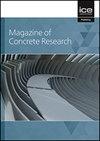非饮用水对混凝土特性强度的概率影响
IF 1.6
4区 工程技术
Q3 CONSTRUCTION & BUILDING TECHNOLOGY
引用次数: 0
摘要
在世界各地,使用非饮用水(SA)制成的混凝土的验收标准是参照使用饮用水(SP)制成的类似混凝土的平均强度。混凝土强度设计的基础是特性强度。验收标准对 SA 和 SP 特性强度的影响首次通过统计模拟进行了研究。结果发现,与两组样本相比,三组样本可提高 SA 的特征强度。SA 和 SP 平均值之间的允许比率越高,单个样本与平均值的偏差越小,SA 的特征强度就越高。原始样本群的变异系数(CoV)对 SA 特征强度的影响各不相同。一方面,较高的 CoV 会降低 SP 的特征强度,从而增加 SA 强度高于 SP 强度的概率。另一方面,SP 的 CoV 越高,意味着样本的分布范围越广,这可能会增加 SA 的 CoV,从而降低 SA 的特征强度。针对上述变量的不同组合,为 SA 和 SP 的特征强度绘制了概率图,并为实际应用提供了指导。本文章由计算机程序翻译,如有差异,请以英文原文为准。
Probabilistic effect of non-potable mixing water on characteristic strength of concrete
Across the world, the acceptance criterion for concrete made with non-potable water (SA) is stipulated for mean strength with reference to similar concrete made with potable water (SP). The basis for the strength design of concrete is the characteristic strength. The effect of the acceptance criteria on the characteristic strength of SA and SP was examined using statistical simulations, for the first time. It was found that, compared with a two-sample set, using a three-sample set would improve the characteristic strength of SA. A higher allowable ratio between the means of SA and SP and a lower deviation of individual samples from the mean would improve the characteristic strength of SA. The effect of the coefficient of variation (CoV) of the original population on the characteristic strength of SA varied. On the one hand, a higher CoV reduced the characteristic strength of SP, thereby increasing the probability of SA strength being higher than SP strength. On the other, a higher CoV of SP meant a wider spread of the samples and that could increase the CoV of SA, thereby reducing the characteristic strength of SA. Probabilistic charts were developed for the characteristic strengths of SA and SP for different combinations of the aforementioned variables, with guidance for practical application.
求助全文
通过发布文献求助,成功后即可免费获取论文全文。
去求助
来源期刊

Magazine of Concrete Research
工程技术-材料科学:综合
CiteScore
4.60
自引率
11.10%
发文量
102
审稿时长
5 months
期刊介绍:
For concrete and other cementitious derivatives to be developed further, we need to understand the use of alternative hydraulically active materials used in combination with plain Portland Cement, sustainability and durability issues. Both fundamental and best practice issues need to be addressed.
Magazine of Concrete Research covers every aspect of concrete manufacture and behaviour from performance and evaluation of constituent materials to mix design, testing, durability, structural analysis and composite construction.
 求助内容:
求助内容: 应助结果提醒方式:
应助结果提醒方式:


